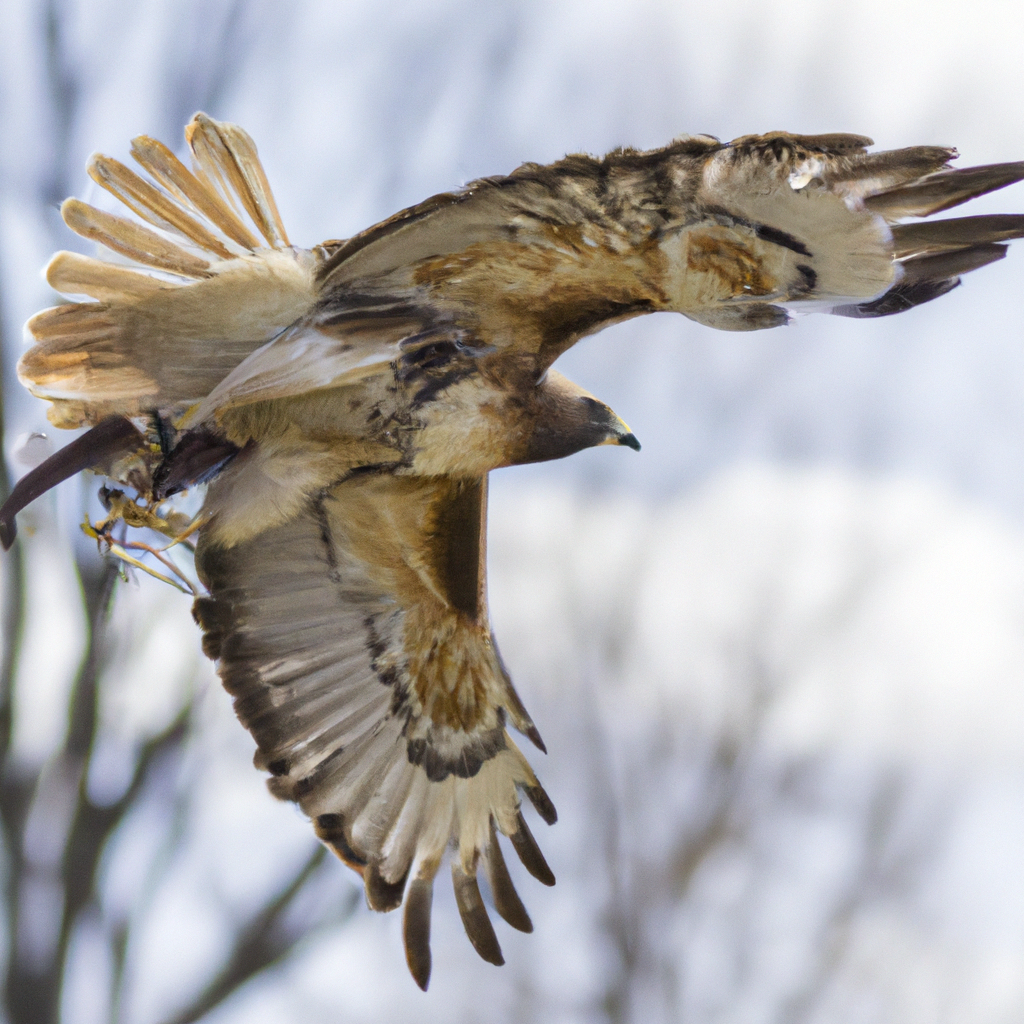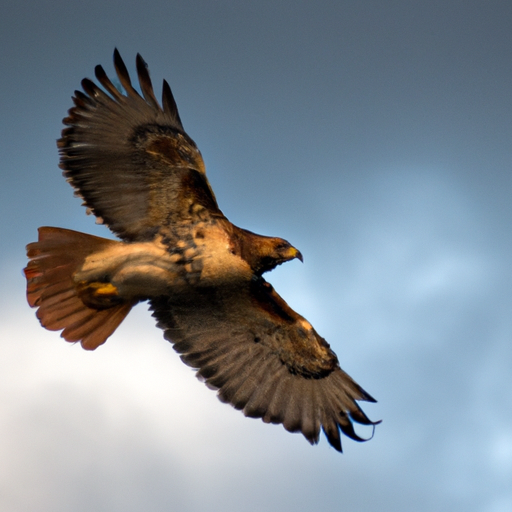In the realm of avian predators, the majestic hawk stands as a symbol of might and efficiency. With impeccable aerial prowess, it effortlessly soars through the sky, captivating onlookers with its graceful movements. However, behind this display of elegance lies a fundamental question that has intrigued scientists and nature enthusiasts alike: how much weight can a hawk truly carry? While the answer to this query may seem straightforward, the intricacies and factors at play are far more complex than one might expect. In this article, we will uncover the fascinating insights into the capabilities and limitations of these remarkable birds of prey, shedding light on their extraordinary powers and enhancing our understanding of their place in the natural world.

An Overview of Hawks
Hawks: A Brief Introduction
Hawks are majestic birds of prey that belong to the family Accipitridae. They are known for their keen eyesight, powerful flight, and sharp talons. These birds have captured the fascination of humans throughout history, symbolizing strength, agility, and freedom. Hawks are widely distributed across various habitats, from forests and grasslands to deserts and mountains. Their diverse species and adaptations make them one of nature’s most skilled and efficient hunters.
Hawk Species and Characteristics
There are numerous species of hawks found around the world, each with its own unique characteristics. Some of the most common hawk species include the Red-tailed Hawk, Cooper’s Hawk, Broad-winged Hawk, and the famous Bald Eagle. Hawks vary in size, with wingspans ranging from 2 to 4 feet and lengths from 1 to 2.5 feet, depending on the species. They typically have sharp beaks, strong legs, and curved talons that enable them to catch and grasp their prey with precision.
Habitat and Distribution
Hawks can be found on every continent except Antarctica, adapting to a wide range of habitats. Some species prefer dense forests, while others thrive in open grasslands or coastal areas. The Red-tailed Hawk, for example, is common in North America and can be found in various environments, from deserts to mountains. Cooper’s Hawks tend to occupy woodlands, while the Peregrine Falcon is often spotted around cliffs and coastal regions. Hawks’ ability to adapt to different habitats contributes to their success as predators.
Hawk Physiology and Adaptations
Physical Characteristics
Hawks possess several physical characteristics that contribute to their hunting prowess. Their keen eyesight is remarkable, with some species having the ability to spot prey from over a mile away. Their vision is so acute that they can detect ultraviolet light, enhancing their ability to track prey and navigate their surroundings. Hawks have sharp, hooked beaks that allow them to tear into their prey and consume their meals efficiently.
Aerodynamic Adaptations
Hawks are superbly adapted for flight, with streamlined bodies and long, broad wings. Their wings provide them with exceptional maneuverability and speed. The shape and structure of their feathers minimize air resistance, allowing hawks to soar effortlessly through the sky. These adaptations enable them to engage in various hunting techniques, such as stooping from great heights or gliding low over the ground, surprising their unsuspecting prey.
Muscle Strength and Talons
Hawks possess powerful muscles that enable them to fly, capture prey, and carry their meals. Their legs are muscular and equipped with sharp, curved talons used for gripping and piercing. These strong talons, paired with sharp claws, allow hawks to subdue their prey effectively. Additionally, hawks have incredible grip strength, which enables them to carry prey while in flight or perch securely on branches.
Factors Affecting a Hawk’s Carrying Capacity
Species Variation
The carrying capacity of hawks can vary significantly between species. Larger hawks, such as the Bald Eagle, are capable of carrying heavier prey compared to smaller species like the American Kestrel. The size and strength of a hawk play a crucial role in determining its carrying capacity.
Age and Size
Within a species, younger hawks generally have a lower carrying capacity than older, more fully developed individuals. As hawks mature and grow larger, their muscles and talons strengthen, allowing them to carry larger prey. The size and age of a hawk are important factors to consider when estimating its carrying capacity.
Environmental Conditions
The environment in which a hawk lives can also impact its carrying capacity. Hawks dwelling in areas with abundant prey and favorable hunting conditions may be capable of carrying larger prey due to the availability of resources. Conversely, hawks residing in ecosystems with limited food sources may have a lower carrying capacity.
Prey Availability
The size and weight of available prey directly influence a hawk’s carrying capacity. Hawks primarily hunt small to medium-sized animals, such as rodents, squirrels, and rabbits. The carrying capacity of a hawk may be limited by the size and weight of these prey species. Factors such as seasonality and local prey populations can also affect a hawk’s access to suitable prey.
Examining the Prey
Types of Prey
Hawks are known for their diverse diets and ability to adapt to various prey options. They hunt a wide range of animals, including mammals, birds, reptiles, and even fish. Small mammals, such as mice, voles, and rabbits, are common targets for hawks. Birds like pigeons, ducks, and songbirds may also become prey for certain hawk species. Snakes and lizards are among the reptiles that hawks have been observed capturing and consuming.
Average Weights of Common Prey
The average weight of prey varies depending on the specific species of hawk and the region in which they are found. Small hawks, such as the Sharp-shinned Hawk, typically prey on birds weighing less than 100 grams (3.5 ounces). Medium-sized hawks, like the Red-shouldered Hawk, may target prey weighing up to 500 grams (1.1 pounds). Larger hawks, such as the Ferruginous Hawk, are capable of taking down mammals weighing over 1 kilogram (2.2 pounds).
Prey Carrying Techniques
When hawks capture their prey, they typically carry it to a safe location for consumption. Hawks employ various techniques to transport their prey, depending on its size. Smaller prey can be carried in the hawk’s talons, while larger prey may be gripped by the beak or carried in the hawk’s feet if suitable. Hawks may carry prey in flight, often returning to a perch to consume their meal.

Case Studies of Weight Carried by Hawks
Research Methodology
To examine the weight carried by hawks, several researchers conducted studies focused on observation and measurement of prey items. They carefully observed hawks hunting and recorded the weight of captured prey. This field research allowed for an understanding of the types and weights of prey that hawks were capable of carrying.
Observations and Measurements
During the studies, researchers observed hawks capturing prey of varying sizes and measured the weight of these prey items. By recording these observations, they were able to establish a range of weights that hawks could carry effectively. These measurements provided valuable insights into the capabilities of different hawk species.
Results and Analysis
The case studies revealed that the weight a hawk can carry is heavily influenced by the species and individual size. Smaller hawk species can carry prey weighing up to their body weight, while larger hawks can manage prey double their weight. The ability to carry prey is also affected by the hunting technique employed and the environment in which the hawk operates. These studies emphasized the importance of species variation and individual size when considering a hawk’s carrying capacity.
Comparing Hawks to Other Birds of Prey
Eagle vs. Hawk
Both eagles and hawks are formidable birds of prey, but there are notable differences in their size and carrying capacity. Eagles are generally larger and more powerful than hawks, allowing them to carry heavier prey. Golden Eagles, for example, can capture and carry prey weighing up to 15 pounds, while Red-tailed Hawks typically carry prey weighing around 4 pounds. Eagles’ larger size and muscular build give them a distinct advantage when it comes to carrying prey.
Falcon vs. Hawk
Falcons and hawks are both skilled hunters with adaptations that enable them to excel in different hunting techniques. Falcons are known for their incredible speed and agility, which allows them to engage in high-speed pursuits of avian prey. While they are lighter than hawks, falcons can carry prey relative to their size. Hawks, on the other hand, are generally larger and have a wider range of prey options due to their diverse hunting techniques.
Owl vs. Hawk
Owls and hawks are nocturnal and diurnal hunters respectively, each with unique adaptations for their preferred hunting conditions. Owls have specialized feathers that allow for silent flight and enable them to surprise prey at night. Owls tend to focus on smaller prey, such as rodents, and do not typically carry their prey over long distances. Hawks, with their powerful flight and daytime hunting habits, are better equipped to capture and carry larger prey over greater distances.
Implications for Survival and Hunting
Carrying Prey for Consumption
The ability to carry prey is essential for the survival of hawks. By capturing and carrying prey, hawks can bring their meals to safe locations away from potential competitors or predators. Carrying prey also allows hawks to consume their meals gradually, increasing their overall energy intake and maximizing the efficiency of their hunting efforts.
Prey Transportation for Nesting
Hawks not only carry prey for consumption but also for their young. During the breeding season, hawks transport prey to their nests to feed their chicks. The carrying capacity of hawks plays a crucial role in determining the food availability for their offspring, ultimately impacting their chances of survival and successful reproduction.
Hunting Strategies and Efficiency
The carrying capacity of hawks influences their hunting strategies and efficiency. Hawks choose prey that they can successfully capture and carry, optimizing their energy expenditure. They prioritize prey that provides sufficient sustenance while considering their ability to transport it effectively. Understanding a hawk’s carrying capacity allows for a deeper appreciation of their hunting behaviors and the efficient use of their resources.
Human Interaction with Hawks
Human Perspectives
Hawks have captivated the human imagination for centuries, featuring prominently in art, literature, and folklore. Their grace, power, and commanding presence have made them symbols of strength and nobility in many cultures. Additionally, hawks are popular subjects for birdwatching and photography enthusiasts, drawing people to nature and heightening their appreciation for these impressive birds.
Hawks as Predators
From time to time, hawks may come into contact with humans when hunting for prey. In urban areas, hawks have occasionally been observed taking small pets, such as small dogs or cats. However, it is important to note that such incidents are relatively rare and hawks do not pose a significant threat to the overall pet population. Understanding the behavior and feeding patterns of hawks can help minimize the potential for conflicts with humans and their pets.
Conservation Efforts and Impact
Hawks, like many birds of prey, have faced habitat loss, pesticide-related issues, and persecution in the past. However, conservation efforts, including habitat preservation and the banning of harmful pesticides, have played a crucial role in protecting and restoring hawk populations. The recovery of certain hawk species, such as the Bald Eagle, is a testament to the effectiveness of conservation initiatives and highlights the importance of preserving these magnificent birds for future generations.

Misconceptions and Myths
Hawks Carrying Away Small Pets
One common misconception about hawks is that they regularly snatch and carry away small pets. While there have been rare instances of hawks preying on small dogs or cats, such incidents are exceptions rather than the norm. Hawks typically focus on hunting smaller prey in their natural habitats, and interactions with pets are infrequent. Proper supervision of pets and understanding hawk behavior can help mitigate any potential risks.
Exaggerated Claims in Media
Media portrayals of hawks sometimes sensationalize their hunting prowess and capabilities, resulting in exaggerated claims. While hawks are formidable hunters, they cannot carry away humans, large livestock, or objects beyond their physical capabilities. It is essential to approach media depictions with a critical mindset and rely on factual information when discussing the capabilities of hawks.
Misinterpretation of Behaviors
The behavior of hawks can sometimes be misinterpreted, leading to misunderstandings. For example, hawks that appear to swoop at people are often misunderstood as aggressive or predatory. In reality, hawks may be defending their territory or engaging in courtship displays. Educating the public about the behavior of hawks can help dispel misconceptions and foster a better understanding and appreciation of these magnificent birds.
Conclusion
Hawks are remarkable birds of prey known for their strength, agility, and fierce hunting abilities. Their diverse species, physiological adaptations, and powerful flight make them formidable hunters across a range of habitats. Hawks’ carrying capacity is influenced by factors such as species variation, age, size, environmental conditions, and prey availability. Understanding their abilities and behaviors is essential for appreciating their significance in ecosystems and their interactions with humans. Conservation efforts contribute to the continued survival and thriving populations of hawks, ensuring their place as a symbol of the wild and a testament to the wonders of the natural world. Further research and knowledge gaps exist, prompting ongoing exploration into the intricacies of hawk physiology, behavior, and their vital role in ecosystems.


